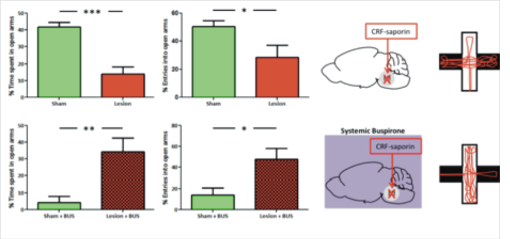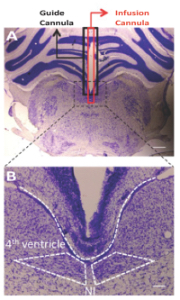By Jigna Rajesh Kumar, [a, b, c, d] Ramamoorthy Rajkumar, [a, b, c] Liying Corinne Lee, [a, b, c] Gavin S. Dawe [a, b, c, d]
[a] Dept Pharmacology, Yong Loo Lin School of Medicine, National University Health System, National University of Singapore, 117600, Singapore [b] Neurobiology and Ageing Programme, Life Sciences Institute, National University of Singapore, 117456, Singapore [c] Singapore Institute for Neurotechnology (SINAPSE), 117456, Singapore [d] NUS Graduate School for Integrative Sciences and Engineering (NGS), National University of Singapore, 117456, Singapore
The nucleus incertus (NI), located strategically at the prepontine brainstem, has widespread connections across the forebrain to various structures involved in arousal, behavioral regulation, anxiety, appetite, and cognition.[5, 6, 9, 11-12, 18-20] The NI expresses one of the highest density of corticotropin releasing factor receptor 1 (CRF1) in the brain. which raised interest in this structure and suggested its possible role in the extra-pituitary behavioral stress response.[16] The NI is the chief source of the neuropeptide relaxin-3, and the NI/relaxin-3 system is highly conserved phylogenetically, pointing to a critical functional role that is presently not well understood.[15, 22]
CRF-saporin (CRF-SAP; Cat. #IT-13) was stereotaxically injected into the NI to enable selective lesioning of the CRF1-expressing NI cells (Fig. 2).[13] This procedure established at our laboratory was found to show significant reduction in the expression of CRF1, relaxin-3, GAD 65 as well as relaxin-3 in a representative target structure, the medial septum.[13] Based on the anxiogenic effect of CRF-SAP lesioning of the NI, as depicted by the significantly reduced time spent, and entries into the open arms of the elevated plus maze, it can be inferred that the NI may act to reduce anxiety physiologically (Fig. 1).

We further utilized this technique to determine if the NI was involved in mediating the anxiety-modulating effects of buspirone, a clinically prescribed novel anxiolytic whose mechanism of action is not well understood.[3-4] Buspirone is a anxioselective drug that acts specifically on symptoms of anxiety without affecting cognition, motor ability, and reward pathways thus indicating that it likely acts on structures that regulate physiological anxiety. Buspirone is a 5-HT1A partial agonist and a D2 receptor antagonist;[14] both receptors are expressed in the NI.[13, 17] Buspirone tends to show anxiolytic effects at a narrow low dose range and anxiogenic effects at a wide high dose range, the latter effect being robust and reproducible.[1, 4, 7, 10, 21] The anxiolytic effects are widely thought to be mediated by the agonism of the 5-HT1A autoreceptors at the raphe nuclei, particularly the median raphe.[2, 8, 23] A 3 mg/kg intraperitoneal dose of buspirone was found to induce a strong anxiogenic effect on various anxiety paradigms, namely the elevated plus maze, the open field, and the light-dark box.[12] This dose was also found to robustly induce c-Fos expression and therefore activate the NI. The anxiogenic effect of systemic buspirone was attenuated when the NI was lesioned by CRF-SAP, thus indicating that the NI plays a role in the effects of buspirone (Fig. 1). Infusing buspirone (5 mcg) into the NI produced increased anxiety as well, suggesting that buspirone may be acting directly on the NI.[12] Pharmacological interaction studies conducted with a 5-HT1A antagonist, NAD 299, and D2/D3 agonist, quinpirole, indicated that these effects are mediated through the 5-HT1A receptors. Intra-NI infusion of NAD 299 attenuated the anxiogenic effects of systemic buspirone while intra-NI quinpirole did not have any effect.[12] Therefore, the NI is likely to be part of the physiological anxiety circuit and the 5-HT1A receptors may be particularly important in mediating this function.

References
- Bradley BF et al. (2011). Anxiolytic and anxiogenic drug effects on male and female gerbils in the black-white box. Behav Brain Res 216: 285-292.
- Carli Met al. (1989). Evidence that central 5-hydroxytryptaminergic neurones are involved in the anxiolytic activity of buspirone. Br J Pharmacol 96: 829-836.
- Chessick CA et al. (2006). Azapirones for generalized anxiety disorder. Cochrane Database Syst Rev: CD006115.
- Collinson N et al. (1997). On the elevated plus-maze the anxiolytic-like effects of the 5-HT(1A) agonist, 8-OH-DPAT, but not the anxiogenic-like effects of the 5-HT(1A) partial agonist, buspirone, are blocked by the 5-HT1A antagonist, WAY 100635. Psychopharmacology (Berl) 132: 35-43.
- Farooq U et al. (2016). Electrical microstimulation of the nucleus incertus induces forward locomotion and rotation in rats. Physiol Behav 160: 50-58.
- Farooq U et al. (2013). Corticotropin-releasing factor infusion into nucleus incertus suppresses medial prefrontal cortical activity and hippocampo-medial prefrontal cortical long-term potentiation. Eur J Neurosci 38: 2516-2525.
- File SE et al. (1991). Low but not high doses of buspirone reduce the anxiogenic effects of diazepam withdrawal. Psychopharmacology (Berl) 105: 578-582.
- File SE et al. (1996). Comparative study of pre- and postsynaptic 5-HT1A receptor modulation of anxiety in two ethological animal tests. J Neurosci 16: 4810-4815.
- Goto M et al. (2001). Connections of the nucleus incertus. J Comp Neurol 438: 86-122.
- Handley SL et al. (1993). 5HT drugs in animal models of anxiety. Psychopharmacology (Berl) 112: 13-20.
- Kumar JR et al. (2015). Evidence of D2 receptor expression in the nucleus incertus of the rat. Physiol Behav 151: 525-534.
- Kumar JR et al. (2016). Nucleus incertus contributes to an anxiogenic effect of buspirone in rats: Involvement of 5-HT1A receptors. Neuropharmacology 110: 1-14.
- Lee LC et al. (2014). Selective lesioning of nucleus incertus with corticotropin releasing factor-saporin conjugate. Brain Res 1543: 179-190.
- Loane C et al. (2012). Buspirone: what is it all about? Brain Res 1461: 111-118.
- Ma S et al. (2007). Relaxin-3 in GABA projection neurons of nucleus incertus suggests widespread influence on forebrain circuits via G-protein-coupled receptor-135 in the rat. Neuroscience 144: 165-190.
- Ma S et al. (2015). Ascending control of arousal and motivation: role of nucleus incertus and its peptide neuromodulators in behavioural responses to stress. Journal of neuroendocrinology 27: 457-467.
- Miyamoto Y et al. (2008). Developmental expression and serotonergic regulation of relaxin 3/INSL7 in the nucleus incertus of rat brain. Regul Pept 145: 54-59.
- Rajkumar R et al. (2013). Acute antipsychotic treatments induce distinct c-Fos expression patterns in appetite-related neuronal structures of the rat brain. Brain Res 1508: 34-43.
- Rajkumar R et al. (2016). Stress activates the nucleus incertus and modulates plasticity in the hippocampo-medial prefrontal cortical pathway. Brain Res Bull 120: 83-89.
- Ryan PJ et al. (2011). Nucleus incertus–an emerging modulatory role in arousal, stress and memory. Neurosci Biobehav Rev 35: 1326-1341.
- Soderpalm B et al. (1989). Effects of 5-HT1A receptor agonists and L-5-HTP in Montgomery’s conflict test. Pharmacol Biochem Behav 32: 259-265.
- Tanaka M et al. (2005). Neurons expressing relaxin 3/INSL 7 in the nucleus incertus respond to stress. Eur J Neurosci 21: 1659-1670.
- Tunnicliff G (1991). Molecular basis of buspirone’s anxiolytic action. Pharmacol Toxicol 69: 149-156.
